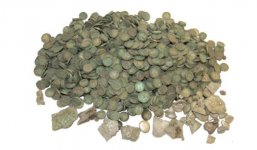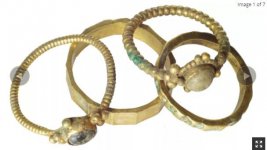6,500 medieval coins and rare gold rings unearthed in Polish cornfield
By Laura Geggel - Editor 16 hours ago
The hoard may include a princess's gold ring.

A medieval hoard brimming with silver ingots, gold rings and thousands of silver coins was recently discovered in a Polish cornfield by an archaeologist, with the help of a priest and local firefighters.
The nearly 900-year-old hoard, found in S?uszków, a village in west-central Poland, held a one-of-a-kind treasure – a gold ring etched with a Cyrillic inscription that translates to: "Lord, may you help your servant Maria."
That ring may have belonged to a princess; the coin stash was certainly fit for one. "The newfound hoard consists of over 6,600 items – silver coins and silver clumbs (tiny ingots) … wrapped in three linen pouches, packed in a basket and then put in the ceramic vessel," Adam K?dzierski, an archaeologist at the Institute of Archaeology and Ethnology at the Polish Academy of Sciences, told Live Science in an email.
K?dzierski said he wouldn't have found the medieval hoard without the help of a local priest. In November 2020, K?dzierski visited S?uszków to learn more about another medieval treasure – one of the largest coin hoards ever found in Poland, which had been unearthed in 1935.
The exact location of the 1935 hoard had never been recorded, and K?dzierski hoped to locate and photograph it for an upcoming book. However, during his stay, K?dzierski happened to talk with a priest, Rev. Jan Stachowiak, who shared a little bit of gossip about the possible location of another hoard.
After using a metal detector to locate the general area where the hoard was buried, K?dzierski and his colleagues dug up a small trench in a cornfield in the village. There, he found a ceramic vessel that held the medieval riches. "The vessel itself, buried only 30 centimeters [nearly 12 inches] under the ground, was completely preserved – only the lid/the upper part was missing," he said.
After realizing the hoard's incredible value, K?dzierski and his team called in local volunteer firefighters to guard the treasure until the excavation was complete, according to The First News, a Polish news outlet.
Most of the coins were silver coins known as cross denarii, minted with the image of a large cross and dating to the end of the 11th century or the beginning of the 12th century, he said. The hoard also held Czech, Danish, Hungarian and German coins, including a denarius coin of Germany's King Henry III.
The "rarest coins" are denarii featuring Sieciech, a high-ranking Polish statesman who served W?adys?aw I Herman, the Duke of Poland from 1079 to 1102, K?dzierski said. The hoard's "biggest sensation," are four golden rings, including the ring with the Cyrillic inscription about the woman named Maria, he said.
Unlike silver trinkets, gold jewelry was extremely rare in Poland during the early Medieval period, K?dzierski said. Perhaps, the newfound gold rings belonged to the first ruling dynasty of Poland, known as the Piast dynasty.

"The treasure (dated back to 1105) might have belonged to Zbigniew, Duke of Poland, and the wedding band wearing the Cyrillic inscription could have been a gift of his grandmother – Dobroniega Maria, a daughter of Vladimir the Great, Prince of Kiev, and a wife of a Polish price, Casimir the Restorer," K?dzierski said in the email.
Now that the hoard has been excavated, researchers will analyze and date the gold and silver pieces as well as the linen pouches and the basket that held these treasures. "Particularly interesting will be establishing the provenance of the gold decoration items," such as the rings, K?dzierski said.
The discovery of this second hoard at S?uszków suggests that the village may have played a more important role in history than previously realized. Perhaps a high ranking official tied to the duke lived in S?uszków, or maybe it was even a temporary residence for Duke Zbigniew, K?dzierski said.
S?uszków is known for other early medieval artifacts; over the years, local farmers have told archaeologists about early medieval vessels and dishes found in their fields, "which may be a sign of [the] remains of stone buildings in the area of S?uszków," K?dzierski said.
Originally published on Live Science.
https://www.livescience.com/medieval-polish-hoard.html
By Laura Geggel - Editor 16 hours ago
The hoard may include a princess's gold ring.

A medieval hoard brimming with silver ingots, gold rings and thousands of silver coins was recently discovered in a Polish cornfield by an archaeologist, with the help of a priest and local firefighters.
The nearly 900-year-old hoard, found in S?uszków, a village in west-central Poland, held a one-of-a-kind treasure – a gold ring etched with a Cyrillic inscription that translates to: "Lord, may you help your servant Maria."
That ring may have belonged to a princess; the coin stash was certainly fit for one. "The newfound hoard consists of over 6,600 items – silver coins and silver clumbs (tiny ingots) … wrapped in three linen pouches, packed in a basket and then put in the ceramic vessel," Adam K?dzierski, an archaeologist at the Institute of Archaeology and Ethnology at the Polish Academy of Sciences, told Live Science in an email.
K?dzierski said he wouldn't have found the medieval hoard without the help of a local priest. In November 2020, K?dzierski visited S?uszków to learn more about another medieval treasure – one of the largest coin hoards ever found in Poland, which had been unearthed in 1935.
The exact location of the 1935 hoard had never been recorded, and K?dzierski hoped to locate and photograph it for an upcoming book. However, during his stay, K?dzierski happened to talk with a priest, Rev. Jan Stachowiak, who shared a little bit of gossip about the possible location of another hoard.
After using a metal detector to locate the general area where the hoard was buried, K?dzierski and his colleagues dug up a small trench in a cornfield in the village. There, he found a ceramic vessel that held the medieval riches. "The vessel itself, buried only 30 centimeters [nearly 12 inches] under the ground, was completely preserved – only the lid/the upper part was missing," he said.
After realizing the hoard's incredible value, K?dzierski and his team called in local volunteer firefighters to guard the treasure until the excavation was complete, according to The First News, a Polish news outlet.
Most of the coins were silver coins known as cross denarii, minted with the image of a large cross and dating to the end of the 11th century or the beginning of the 12th century, he said. The hoard also held Czech, Danish, Hungarian and German coins, including a denarius coin of Germany's King Henry III.
The "rarest coins" are denarii featuring Sieciech, a high-ranking Polish statesman who served W?adys?aw I Herman, the Duke of Poland from 1079 to 1102, K?dzierski said. The hoard's "biggest sensation," are four golden rings, including the ring with the Cyrillic inscription about the woman named Maria, he said.
Unlike silver trinkets, gold jewelry was extremely rare in Poland during the early Medieval period, K?dzierski said. Perhaps, the newfound gold rings belonged to the first ruling dynasty of Poland, known as the Piast dynasty.

"The treasure (dated back to 1105) might have belonged to Zbigniew, Duke of Poland, and the wedding band wearing the Cyrillic inscription could have been a gift of his grandmother – Dobroniega Maria, a daughter of Vladimir the Great, Prince of Kiev, and a wife of a Polish price, Casimir the Restorer," K?dzierski said in the email.
Now that the hoard has been excavated, researchers will analyze and date the gold and silver pieces as well as the linen pouches and the basket that held these treasures. "Particularly interesting will be establishing the provenance of the gold decoration items," such as the rings, K?dzierski said.
The discovery of this second hoard at S?uszków suggests that the village may have played a more important role in history than previously realized. Perhaps a high ranking official tied to the duke lived in S?uszków, or maybe it was even a temporary residence for Duke Zbigniew, K?dzierski said.
S?uszków is known for other early medieval artifacts; over the years, local farmers have told archaeologists about early medieval vessels and dishes found in their fields, "which may be a sign of [the] remains of stone buildings in the area of S?uszków," K?dzierski said.
Originally published on Live Science.
https://www.livescience.com/medieval-polish-hoard.html








